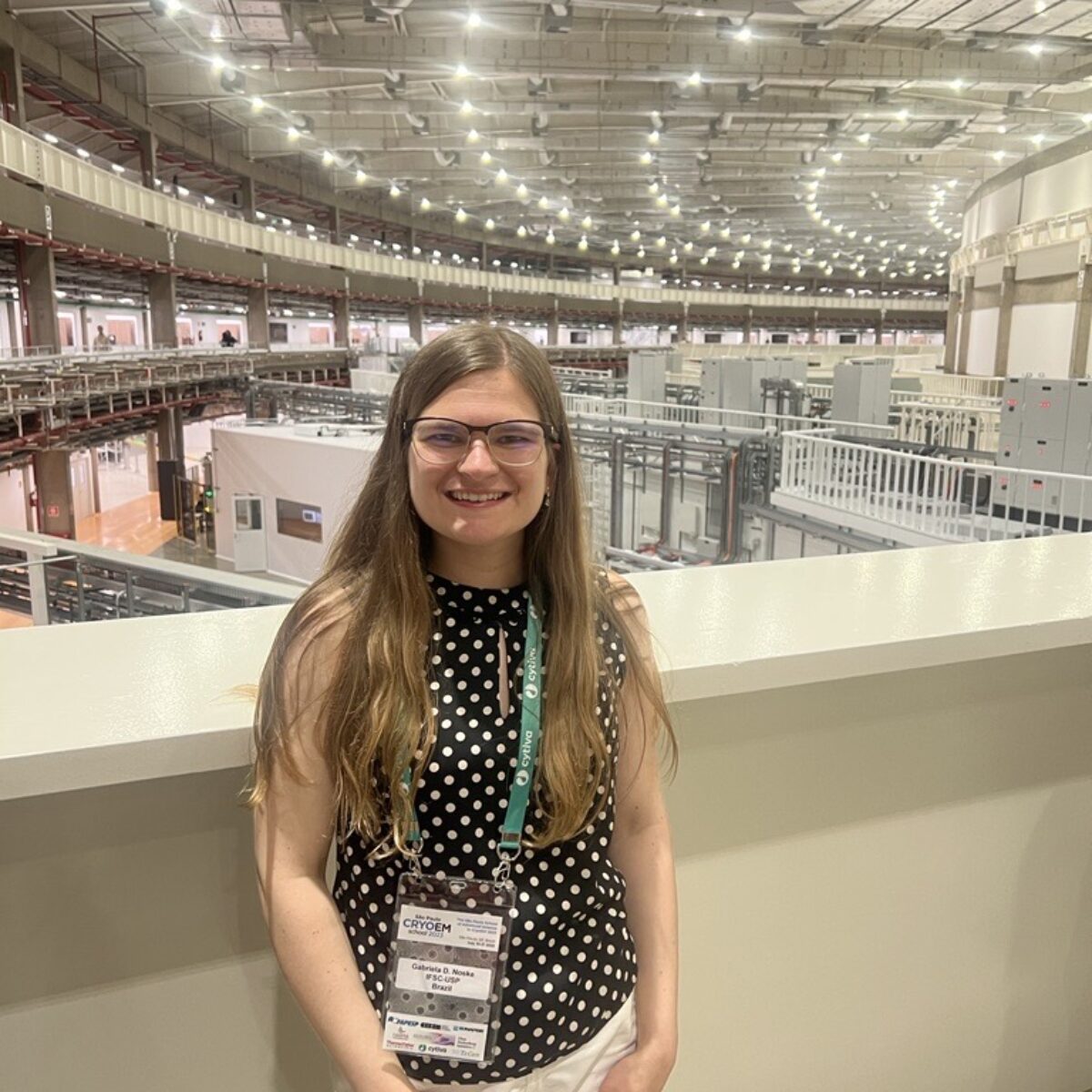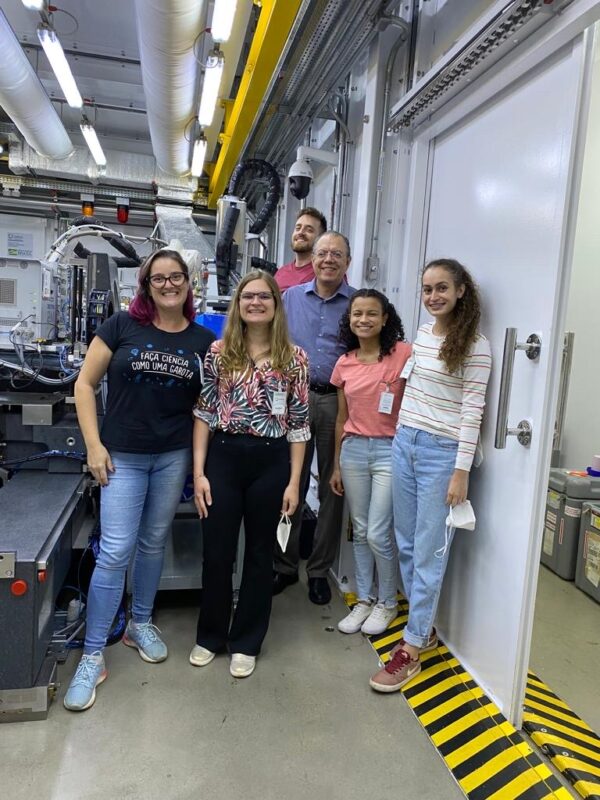
Researcher Gabriela Noske, winner of the Herbert Tabor Early Career Investigator Award for work published in the Journal of Biological Chemistry.
A study published in the Journal of Biological Chemistry analyzed polymorphisms in one of the main pharmacological targets of antivirals that combat Covid-19
The American Society for Biochemistry and Molecular Biology (ASBMB) announced Gabriela Noske, currently a researcher in the cryomicroscopy group at the Brazilian Nanotechnology National Laboratory (LNNano), as one of the winners of the Herbert Tabor Early Career Investigator Awards, sponsored by the Journal of Biological Chemistry.
In their article published in that journal in March 2023, she and her colleagues used measurements obtained from the Manacá beamline to characterize different polymorphisms of the protease of the virus that causes COVID-19, and their relationship with the effectiveness of antivirals developed during the pandemic. This research was part of Noske’s doctoral work at the São Carlos Institute of Physics at the University of São Paulo (USP).
“It’s a feeling of accomplishment. Seeing your work recognized is seeing that all the effort up to this point was worthwhile. I hope it is the beginning of a long scientific career. It is also very satisfying to see Brazilian science recognized internationally,” notes Noske.
The study and measurements obtained using Manacá
Treating viral infections with medications is a huge challenge. Viruses hide inside the cells of the organisms they infect, and take over their structures to make copies of themselves, which is how they spread and infect other individuals.
Using medications against something hidden within the cells of our bodies (such as the virus that causes COVID-19) is very complicated. Like HIV, SARS-CoV-2 depends on a kind of enzyme called a protease to process the proteins that are essential for the virus to replicate. This enzyme, known as the main protease (Mpro), is an excellent pharmacological target because of its importance in the virus life cycle.
Finding a molecule that can inhibit the main protease’s function has been an objective for many scientists since the start of the pandemic; nirmatrelvir and ensitrelvir are two medications that resulted from these efforts, known as protease inhibitors. Nirmatrelvir, manufactured by Pfizer and prescribed under the trade name Paxlovid, was approved for sale in Brazil by ANVISA, the national health agency, in November 2022. Ensitrelvir, which is produced by the Japanese pharmaceutical company Shionogi in partnership with the University of Hokkaido, was approved for use in Japan.
Unfortunately, widespread use of antivirals is often associated with the emergence of resistance to these medications. Identifying potential mutations that can affect the activities of these molecules and quantifying how they impact effectiveness when they bind to the main protease of SARS-CoV-2 are essential to monitoring and combating this virus, and the study published in the Journal of Biological Chemistry was the fruit of this work.
The researchers used genetic sequencing data collected on SARS-CoV-2 to find variants with small differences in the regions of the main protease where the medications in question bind to carry out their function and inhibit the enzyme’s activity. They identified 15 different mutations that could potentially affect the activity of nirmatrelvir, and two demonstrated strongly reduced inhibitive action.

Group of scientists during measurement period at the Manacá beamline at Sirius.
For ensitrelvir, 13 different mutations were selected, three of which demonstrated strong reductions in inhibition. The proteins with these mutations were crystallized, and the researchers were able to use the Manacá beamline at Sirius, in the Brazilian Synchrotron Light National Laboratory (LNLS), to characterize the structure of the polymorphisms using x-ray crystallography.
The reduction in inhibitive activity observed in the studied mutations does not necessarily mean that they will be naturally selected and become part of a new SARS-CoV-2 variant of concern. Along with widespread use of these medications, it is also important to know which mutations are not harmful to the virus life cycle, or which are accompanied by other compensating and beneficial mutations.
Still, studies like these are essential to monitor the emergence of variants that could potentially evade available treatments. If one or more are identified in a new variant of the virus that begins to circulate more intensely, scientists will know that this fact could potentially make these medications less effective. And before this can happen, other teams of scientists can use data (like the information obtained for this research) to develop a new generation of protease inhibitors.
“Collecting data at Manacá was something that greatly impressed me, as a researcher as well as personally. During a pandemic, it was incredible to see myself as someone who had the tools needed to help society face these situations, and to be there doing something concrete. At the same time, all the pressure required a lot, mentally and physically, from everyone who was involved in the project. It is certainly something I will never forget,” said Noske.
A sophisticated and effervescent environment for research and development, unique in Brazil and present in few scientific centers in the world, the Brazilian Center for Research in Energy and Materials (CNPEM) is a private non-profit organization, under the supervision of the Ministry of Science, Technology and Innovation (MCTI). The Center operates four National Laboratories and is the birthplace of the most complex project in Brazilian science – Sirius – one of the most advanced synchrotron light sources in the world. CNPEM brings together highly specialized multi-thematic teams, globally competitive laboratory infrastructures open to the scientific community, strategic lines of investigation, innovative projects in partnership with the productive sector and training of researchers and students. The Center is an environment driven by the search for solutions with impact in the areas of Health, Energy and Renewable Materials, Agro-environment, and Quantum Technologies. As of 2022, with the support of the Ministry of Education (MEC), CNPEM expanded its activities with the opening of the Ilum School of Science. The interdisciplinary higher course in Science, Technology and Innovation adopts innovative proposals with the aim of offering excellent, free, full-time training with immersion in the CNPEM research environment. Through the CNPEM 360 Platform, it is possible to explore, in a virtual and immersive way, the main environments and activities of the Center, visit: https://pages.cnpem.br/cnpem360/.
Phenomenon is an obstacle to agricultural productivity and reforestation, especially in Northeastern Brazil
Applications will be accpeted until 15 April 2024 trought the event's website.